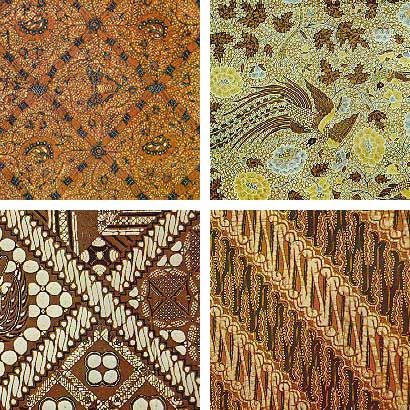 Batik is one way of making fabric. Besides batik can refer to two things. The first is the technique of coloring cloth using the night to prevent staining part of the fabric. In the international literature, this technique is known as a wax-resist dyeing. The second notion is the fabric or clothing made with these techniques, including the use of certain motifs that have uniqueness. Batik Indonesia, as the overall engineering,
Batik is one way of making fabric. Besides batik can refer to two things. The first is the technique of coloring cloth using the night to prevent staining part of the fabric. In the international literature, this technique is known as a wax-resist dyeing. The second notion is the fabric or clothing made with these techniques, including the use of certain motifs that have uniqueness. Batik Indonesia, as the overall engineering,  technology, and development and associated cultural motifs, UNESCO has been designated as a Cultural Heritage for Humanity Oral and Nonbendawi (Masterpieces of the Oral and Intangible Heritage of Humanity) since October 2, 2009.
technology, and development and associated cultural motifs, UNESCO has been designated as a Cultural Heritage for Humanity Oral and Nonbendawi (Masterpieces of the Oral and Intangible Heritage of Humanity) since October 2, 2009.  Art coloring coloring fabric with prevention techniques using night is one of the ancient art form. The discovery in Egypt show that this technique has been known since the 4th century BC, with the discovery mummy wrapping cloth which is also coated the night to form a pattern. In Asia, a similar technique of batik is also applied in China during the T'ang Dynasty (618-907) as well as in India and Japan during the Nara
Art coloring coloring fabric with prevention techniques using night is one of the ancient art form. The discovery in Egypt show that this technique has been known since the 4th century BC, with the discovery mummy wrapping cloth which is also coated the night to form a pattern. In Asia, a similar technique of batik is also applied in China during the T'ang Dynasty (618-907) as well as in India and Japan during the Nara  period (645-794). In Africa, such as batik technique known by the Yoruba tribe in Nigeria, as well as the Soninke and Wolof tribe in Senegal. . In Indonesia, batik is believed to have existed since the time of Majapahit, and became very popular late eighteenth century or early nineteenth century. Produced batik batik is it all until the early twentieth century and the new stamp batik known after World War I or around the 1920's.
period (645-794). In Africa, such as batik technique known by the Yoruba tribe in Nigeria, as well as the Soninke and Wolof tribe in Senegal. . In Indonesia, batik is believed to have existed since the time of Majapahit, and became very popular late eighteenth century or early nineteenth century. Produced batik batik is it all until the early twentieth century and the new stamp batik known after World War I or around the 1920's.  Although the word "batik" comes from the Javanese, the presence of batik in Java itself was not recorded. G.P. Rouffaer argues that the batik technique is likely introduced from India or Sri Lanka in the 6th century or the 7th. On the other hand, J.L.A. Brandes (Dutch archaeologist) and F.A. Sutjipto (archaeologist Indonesia) believe that the tradition of batik is a native of the area such as the Toraja, Flores,
Although the word "batik" comes from the Javanese, the presence of batik in Java itself was not recorded. G.P. Rouffaer argues that the batik technique is likely introduced from India or Sri Lanka in the 6th century or the 7th. On the other hand, J.L.A. Brandes (Dutch archaeologist) and F.A. Sutjipto (archaeologist Indonesia) believe that the tradition of batik is a native of the area such as the Toraja, Flores,  G.P. Rouffaer gringsing also reported that the pattern has been known since the 12th century in Kediri, East Java. He concluded that this pattern can only be formed by using a canting, so he argues that the canting is found in Java in the period surrounding it. Detailed carvings that resemble batik cloth worn by the Prajnaparamita, the goddess of wisdom Buddhist statues from East Java century -13. Detailed patterns of clothing featuring vines and intricate flowers that are similar to
G.P. Rouffaer gringsing also reported that the pattern has been known since the 12th century in Kediri, East Java. He concluded that this pattern can only be formed by using a canting, so he argues that the canting is found in Java in the period surrounding it. Detailed carvings that resemble batik cloth worn by the Prajnaparamita, the goddess of wisdom Buddhist statues from East Java century -13. Detailed patterns of clothing featuring vines and intricate flowers that are similar to Post Title
→OF BATIK INDONESIA
Post URL
→http://annsquiltingjourney.blogspot.com/2011/06/of-batik-indonesia.html
Visit annsquiltingjourney for Daily Updated Wedding Dresses Collection







